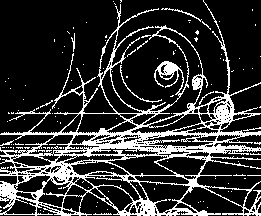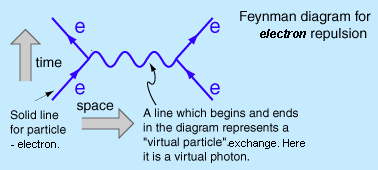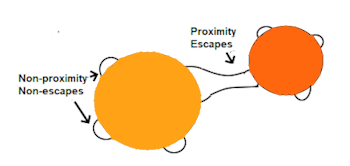Standard Model physics theories

In current physics 'The Standard Model Theory' might maybe now be better called 'The Undefined Model Theory'. And two different basic types of Standard Model theory are current - a Cartesian particle version where its 'forces' are simple particle exchanges with push-force exchanges of momentums, and a field energy version where its 'particles' are energy or field quanta with forces. But in both version theories the particles or quanta forces have poorly defined 'charges' including 'colour-charges' and other aspects that do not seem to fit any Descartes-type particle definition (only size, shape and motion), and the alternative energy or field quanta seem to be equally poorly defined energies of nothing or fields of nothing based on waves of nothing ? But some currently support a duality version of Standard Model physics, where every particle is either a fermion or a boson and they have conflicting properties. So fermions cannot occupy the same space and are matter push-force particles, while bosons can space-overlap and are non-push-force particles or force-signals. Here basically fermions are Galileo-Descartes push-particles, and bosons are Gilbert-Newton distance force signals. You then have your cake and eat it ! (But to be fair pro-signal Gilbert did seem to maybe also allow some push somehow, and it seems that multiple-fermions or multiple-bosons may not always fit this fermion-boson rule.)
Maybe the study of the heavens is Astronomy, the study of physical matter is Chemistry and the study of physical forces is Physics. Then we should maybe talk of Standard Model Chemistry as being the extension of Periodic Table Chemistry.
But the three areas do have strong real connection and are not really separate. And of course Periodic Table Chemistry is a widely backed and well defined piece of science, unlike a much more contentious and poorly defined Standard Model Physics.
Standard Model physics theories.
Standard Model physics is based around matter being composed of
some specified set of elementary particles (or wave-packets), now taking Protons and Neutrons that were formerly considered 'elementary particles' as being compound particles or Hadrons along with maybe some others like LHC in 2012 called Xib' and Xib*.
Sub-atomic particles are generally grouped into different types whose definitions have varied, but currently they are chiefly split either between Hadrons and Leptons, or between Fermions and Bosons.
Hadrons are generally defined as having sub-structure in being composed of quarks and are of two types, Mesons composed of an equal number of quarks and antiquarks (usually one of each) and are Bosons, and Baryons which are composed of odd numbers of quarks (at least 3) and as being Fermions.
Leptons are generally defined as having no sub-structure and all as being Fermions
So in current Standard Model theory, elementary particles can include Fermion particles involving 1 stable family pair
of Quarks with 1 stable family pair of Leptons (electrons, muons and taons)
plus 2 unstable family pairs of Quarks with 2 unstable family pairs
of Leptons. And additional Boson particles are also commonly postulated,
including 'massless' Gluon, Photon and Graviton 'particles', though some in particle physics
favour rather more particles and others favour somewhat less particles.
Particle ........... Mass Equivalents in GeV, ie Giga (or thousand million) electronvolts Energy
Fermions (including Baryons):
up quark ............... 0.005000000
down quark .......... 0.009000000
electron ................ 0.000510000
electron neutrino .. 0 or 0.000000007 ?
charm quark ......... 1.350000000
strange quark ....... 0.175000000
muon .................... 0.106000000
muon neutrino ...... 0 or 0.000270000 ?
top quark ......... 173.000000000
bottom quark ....... 4.500000000
tau ....................... 1.780000000
tau neutrino ......... 0 or 0.030000000 ?
sterile neutrino (x?) ................. 0 ?
neutralino (x4) ........................... ?
(eg WIMP neutralino ... 7-99.000000000 ?)
Bosons (including Mesons):
gluon (x8) ............. 0.000000000
photon .................. 0.000000000
graviton ................ 0.000000000 ?
graviton spin-0 ..... 0.000000001 ?
graviton spin-2 ..... 0.000000001 ?
axion .................... 0.000000001 ?
W+ ..................... 80.20000000 or 81.000 ?
W- ...................... 80.20000000 or 81.000 ?
Z ......................... 91.200000000
higgs ................ 500.000000000 ?
..................... or 125.000000000 ?
X17 ...................... 0.017000000 ?
pionu upQ/-upQ ................ 0.000000000 ?
pionu+ upQ/-downQ .......... 0.000000000 ?
piond downQ/-upQ ............ 0.000000000 ?
piond+ downQ/-downQ ...... 0.000000000 ?
And with maybe more or less particles suggested by different versions of Standard Model and by different versions of String Theory ?
Currently the existence of some of the above Standard Model particles is hypothetical only
and not supported by experimental evidence to date, including such hypothetical particles as
have been theoretically postulated most recently like the X17 Boson which is also claimed by some to produce some new force.
Gluons are claimed to have 8 'colour-charge' types being forms of
red + blue + anti-red + anti-blue, or red + green + anti-red +
anti-green, or blue + green + anti-blue + anti-green. And the various quarks are claimed
to combine to help form neutrons, protons and other composite particles termed Hadrons.
Fermions are claimed to have half-integer 'spin' and to obey Fermi-Dirac behaviour
with multiple fermions being unable to exist in the same quantum state or same space.
They basically are Descartes push-particles. But some giving 'mass' to an elementary particle may
really be just giving the mass-equivalence of its energy.
Bosons are claimed to have integer 'spin' and to obey Bose-Einstein behaviour in
that multiple bosons can occupy the same quantum state or same space.
They basically are more like energy wave packets or signals than like classical mass particles.
While some bosons are claimed to have 'mass' others are claimed to not, and some
bosons like photons are readily detected but others seem impossible to detect.
Bosons are generally problematic in standard model physics, as is its explanation
of at-a-distance-forces as being due to 'virtual boson' exchange. Protons and Electrons
are claimed to electrically attract eachother by Virtual Photon exchange in an
Electrical Interaction force, and Protons and Neutrons composed of Quarks are
claimed to internally bond by Virtual Gluon exchange attraction in a Strong Interaction
force that increases with distance unlike other forces. Protons and Electrons are also
claimed to weakly attract eachother by Virtual W and Z boson exchange in an Electroweak
Interaction force. Mass particles are claimed to gravitationally attract eachother by Virtual
Graviton exchange in a Gravitational Interaction force that may be mediated by the Higgs boson.
These virtual particle exchanges are said to be unobservables, and have no well defined mechanisms for their appearing or vanishing in a vacuum or in any medium.
Of course normal particle exchange in a Descartes
particle physics might seem a reasonable recoil explanation for a
universal repulsion force if there was any such, but is trickier
for the attractive forces and for the selectivity of forces actually
shown by nature. Of course simple particle contact collisions could
look similar to repulsions. Virtual particle exchange may seem to
need some attraction mechanism as well as a signal mechanism for
prompting exchanges. Forces cannot be directly shown to be due to
'force-carrying particles', since eg a photon beam does not produce
electric attraction and a static-electricity charged object does not
produce a photon beam. And of course photons show a wide range
of variation that electric charge does not show.
Of course elementary particle 'spin' properties cannot define any particle motion as they pretend to,
and elementary particle 'color-charge', 'up/down' and otherwise named properties cannot define any particle attributes that they pretend to define.
Most likely all such elementary particle properties are really different signal-response properties.
Standard Model physicists Peter Higgs and Francois Englertis got a 2013 Nobel prize for their
theory prediction for the Higgs Boson being that it would be around 500GeV, though the new particle
being acclaimed as being the Higgs Boson is actually around 126GeV. Now 500GeV is nearly 400% of 126GeV,
so modern physics theories having errors of around 400% is OK. But the same physicists claim that
Newtonian physics is entirely disproved because in some cases it gives a below 1% error !
Standard Model physics uses various Feynman diagrams, where only lines
entering or leaving a diagram represent observable particles. Hence below
two electrons enter a repulsion interaction, supposedly exchanging unobservable virtual
photons, and then exit. (of course this might involve the exchange of some actual proximity-photons hard to detect or some other causal mechanism. Events taking place only in close proximity to an elementary particle may well be hard to observe.) ;

Elementary particles maybe emitting regular non-escape proximity-photons or proximity particles/signals that at times escape only in a proximity situation so that the related force does not simply decrease with distance ;

Charged fermion 'particles' are all claimed by some to have
'anti-particles' of similar mass but opposite charge that can form
'anti-matter' - eg Anti-Hydrogen composed of an Antiproton and a
Positron akin to Hydrogen composed of a Proton and an Electron.
But the 'charges' of matter particles and anti-matter particles are
claimed to differ so as not to affect each other, and a particle and its
'oppositely charged' anti-particle are claimed to undergo spontaneous
'annihilation interactions' where both fully convert to photons. Some fermion particles are also claimed
to spontaneously or magically convert into eachother. Uncharged
anti-particles are generally unexplained and evidence on anti-particle
behaviour is very thin, with strangely little anti-matter seeming to exist.
There are more reasonable claims that much 'dark matter' exists, probably
being just uncharged free non-atomic particles like massive WIMP neutrinos or tiny Axions. Claims of
'dark energy' look weaker, as noted in our
Gravity
section. Multi-particle composites like atoms composed of an even number
of half-spin fermions, or any number of interger-spin bosons, may have overall
interger spin like bosons yet not behave as bosons. And some Standard Model
particles are, like some radioactive atoms, very unstable and may be of little
significance in nature.
There are four fundamental forces in Standard Model
physics theories, the activities of which are generally defined as being ;
- Gravitational force, acting on particles termed mass particles.
- Electromagnetic force, acting on particles termed charged particles.
- Strong force, acting on particles termed coloured particles.
- Weak force, acting on particles termed left-handed particles.
In an information physics this might perhaps be better redefined, explaining particle properties and forces better for a signal physics, as ;
- Particles that respond to Gravitational force signals are termed mass particles.
- Particles that respond to Electromagnetic force signals are termed charged particles.
- Particles that respond to Strong force signals are termed coloured particles.
- Particles that respond to Weak force signals are termed left-handed particles.
See also our Information Physics section.
Of course signal-response systems have been built that produce several responses to one signal,
or produce different responses to different signals. So the above are not the only possible
definitions of forces and/or of 'particles', and several sets of such definitions might well
allow of the same force response event mathematics.
There is some strong evidence that forces seem to become very digital at
close distances, so sub-atomic particle bindings/ energies/ masses/ lifetimes
all seem to involve very narrow and possibly specific mass/energy levels.
This contrasts greatly with the apparent gradation of force effects in the
universe at macroscopic levels. It is not clear if this applies to only some
forces like the strong force, or to all forces including whatever collision force
is. So it is not clear what the real general explanation is, or if there is one
general real explanation involved or maybe more than one. It is not clear
if sub-atomic force evidence favours some one general physics theory or may
fit with some several general physics theories if appropriately specified.
A 'counter-intuitive' or ridiculous strong nuclear force is proposed by David Gross
for which a signal-response physics seems to offer a more logical explanation as in our
String Theory section.
There have been some perhaps poorly defined claims that at very close distances
these forces may be the same strength and effectively be just one force. But it is
claimed by David Toms that the electric charge force which generally get stronger
closer to its source, in fact very close to its source starts getting weaker the
closer the distance - with this effect claimed to be somehow caused by gravity !?
There are also claims that these forces are all due to the sending of some 'Messenger
Particles' or 'Force Photons' back and forth. But of course Standard Model physics theories really struggle to handle Gravity, Dark Matter or Dark Energy issues.
And some physicists do support Einstein's view that gravitational force differs fundamentally from the other forces.
Now when there are two contradictory theories of something as with the two types of Standard Model Theory, forcefield or particle-push,
as long as science rejects contradiction then at least one of the two contradictory theories must be wrong and both may be wrong but both cannot be right.
And science really must reject any contradiction, despite the contradictory view of supporting contradiction by some in science like Einstein.
You can listen to some interesting recent lectures by some physicists on
related experiments and some interpretations of them, at http://viavca.in2p3.fr/site.html
Or regarding claims for an increasing variety of unstable multi-quark hadrons such as 'charged charmoniums', see http://physicsworld.com/cws/article/news/2013/jun/18/charged-charmonium-confounds-particle-physicists
Cartesian, Field and Duality versions of 'Standard Model Physics' are supported by different physicists mostly claiming falsely that theirs is the one and only 'Standard Model Physics' and not really attempting to prove or disprove each other so really making a mockery of science.
And the differing supporters of 'Einstein Physics' do exactly the same shamefully.
Of course some physicists now generally support contradiction-allowed duality physics as
where the 'elementary particles' both are 'wave packets' and are 'not-wave particles'.
Others prefer to basically go with only one of these alternatives. And one option involving no contradiction
might be taking 'elementary particles' as being multi-particle 'vibrations'
composed of many standard particles allowing standard wave motion
among their parts ? And anything claimed to be 'massless' can maybe only be proved to not have a big mass,
since a claim that something has zero mass can be taken as requiring proof that A.) it produces zero gravity and/or proof that B.) it shows zero response to gravity. But this may be impossible to definitely prove if 'infinitely close to zero' cannot be definitely measured ?
And it may be even more complicated because where gravity is stronger, some other forces may also be stronger.
Maybe mass is just one force or signal response and is not 'solidity' and really there are no 'solid' particles, there is only a range of particles with some of a range of attractive and repulsive forces of differing strengths that can vary over distance by some range of powers ?
Solidity and non-solidity may be only apparent differences, hence two different gasses can occupy the same volume without their atoms occupying the same spaces and two liquids may mix or may not mix without requiring anything about their atoms actually occupying the same space only them showing some relative location responses similar to what remote-control boats can be made to show.
Standard Model physics today is mostly used by those employed in particle physics,
often along with some version of Quantum Mechanics. But particle physics experiment is
now often statistical experiment physics, and the real physics often boils down to statistical
significance interpretation - and most physicists are poor statisticians. Modern physics
'experiment' often has the same basic statistics weakness as much modern medical
'experiment'. Some of the very different Standard Model theories maybe look like actually being image theories
though no published Standard Model physicist seems to have studied that issue yet. Standard Model theories perhaps realistically represent more a promising physics
awaiting a properly defined theory, and currently offer no real explanation for the strange assortments of particle masses observed to date ?
Yet the universal current claim that there is and has always been some one Standard Model Theory is a fraud, but unfortunately is only one of the many frauds current in physics today making much of physics really no longer proper science.
OR if you like this site you could maybe make a donation ; It will help with site development, and just possibly with some key physics experiments long planned but never afforded.
[PS. and you may perhaps help make history for science ?]
(The fictional time-travel and multi-universe type ideas of modern physics theory have long totally discouraged certain lines of physics experiment despite there being strong reasons to believe them to be very promising if not essential lines of experiment. Some such lines of experiment considered here identified as early as the 1960s seem still to have had no work done on them and there is maybe not much more time here for this. Science funding both government and private unfortunately now all goes to basically safe standard mainstream science, and no money at all goes to any really innovative risky science though that might pay a thousand times greater.)
You are welcome to link to any page on this site, eg www.new-science-theory.com/the-standard-model.php
otherwise, if you have any view or suggestion on the content of
this site, please contact :- New Science
Theory
Vincent Wilmot 166 Freeman Street Grimsby Lincolnshire DN32
7AT.
© new-science-theory.com, 2025 - taking care with your privacy, see New Science Theory HOME.